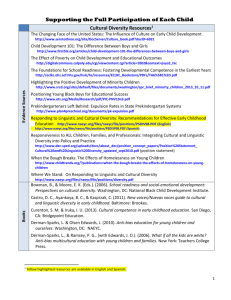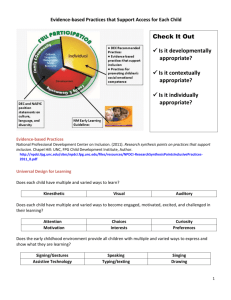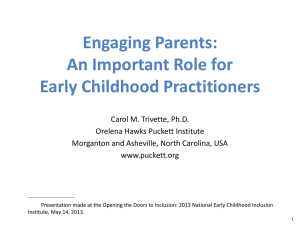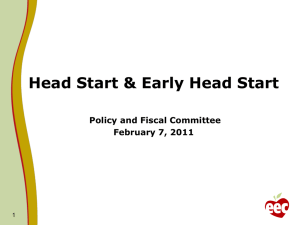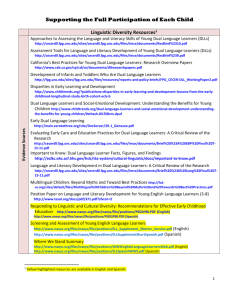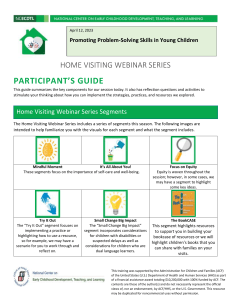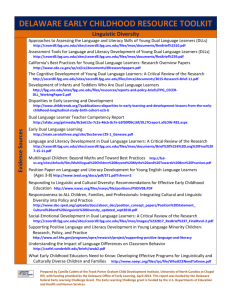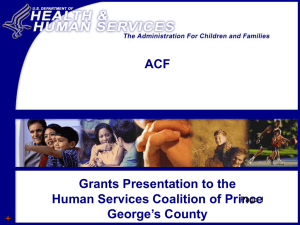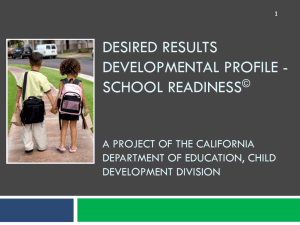Building a System of Assessment for All Children
advertisement
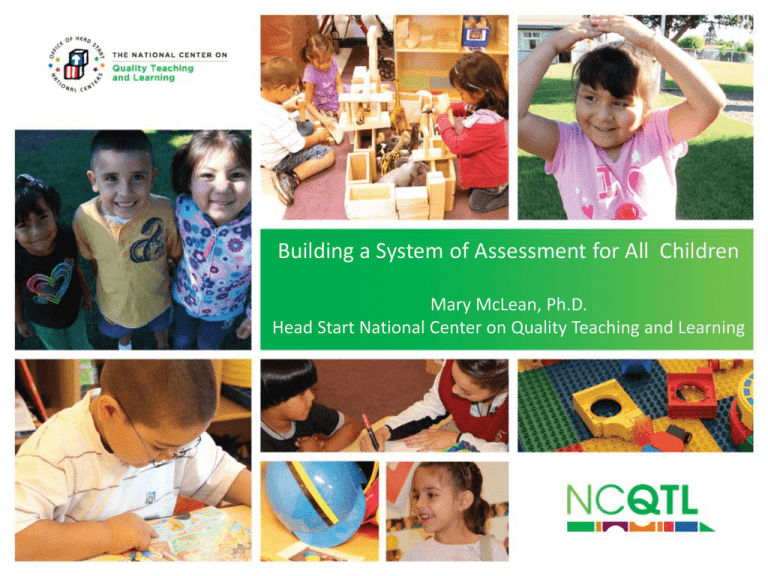
Building a System of Assessment for All Children Mary McLean, Ph.D. Head Start National Center on Quality Teaching and Learning NATIONAL CENTER FOR QUALITY TEACHING AND LEARNING http://eclkc.ohs.acf.hhs.gov/hslc/ttasystem/teaching 2 Framework for Effective Practice Supporting school readiness for all children 3 AGENDA Overview of child assessment requirements for 0-3 and preschool programs Consider requirements for your state/program Building a system of assessment for all children 1) Selecting an appropriate tool 2) Assessing children with disabilities and children who are dual language learners 3) Using assessment to inform teaching INTRODUCTIONS OVERVIEW OF ASSESSMENT REQUIREMENTS 6 Purposes of Assessment • Screening • Evaluation to determine eligibility for special education • Assessment for program planning, monitoring child progress • Program evaluation, accountability Federal Requirements 1993 Government Performance and Results Act 2001 No Child Left Behind 2002 Good Start, Grow Smart (Head Start NRS) 2004 IDEA Improvement Act 2006- Changes to Head Start Regulations 2009 Race to the Top/Early Learning Challenge IN GOD WE TRUST FROM EVERYONE ELSE WE REQUIRE DATA Multiple early childhood systems State-funded preschool Child care centers Early childhood special education Head Start/Early Head Start Home visitor programs From Committee on Developmental Outcomes and Assessments for Young Children • “…early childhood assessment needs to be viewed not as an isolated process, but as integrated in a system” (p 303) • “The states and the federal government often effect change in the early childhood system by introducing new programs, local or limited innovations, and underfunded mandates.” National Research Council. (2008). Early Childhood Assessment: Why, and How. Committee on Developmental Outcomes and Assessments for Young Children, C.E. Snow and S.B. Van Hemmel, Editors, Board on Children, Youth, and Families, Board on Testing and Assessment, Division of Behavioral and Social Sciences and Education. Washington, DC: The National Academies Press. A closer look at federal assessment requirements for Head Start and IDEA ….. Assessment in Head Start • The Head Start Program Performance Standards (1304 & 1308) define and describe ‘assessment’ as a process that includes: – Screening – Developmental evaluation (if needed) – Ongoing assessment Program Evaluation The Designation Renewal System (DRS) (1307) requires programs to “aggregate child-level data” and to examine the summary information for groups of children in the program – This is assessment for the purpose of program evaluation and to support continuous improvement. Performance Standard 1307.3 (b)(2)(i) – (i) Aggregating and analyzing aggregate child-level assessment data at least three times per year (except for programs operating less than 90 days, which will be required to do so at least twice within their operating program period) and – using that data in combination with other program data to determine grantees' progress toward meeting its goals, to inform parents and the community of results, – to direct continuous improvement related to curriculum, instruction, professional development, program design and other program decisions; Performance Standard 1307.3 (b)(2)(ii) • (ii) Analyzing individual ongoing, child-level assessment data for all children birth to age five participating in the program and • using that data in combination with input from parents and families to determine each child's status and progress with regard to, at a minimum, language and literacy development, cognition and general knowledge, approaches toward learning, physical wellbeing and motor development, and social and emotional development and • to individualize the experiences, instructional strategies, and services to best support each child. 1307.3 (b)(2)(ii) Newly Revised! 1 • School Readiness Plan is developed • School Readiness Goals are established in the five essential domains 2 • Evidence-based curricula and teaching strategies are adopted • High quality teacher-child interactions and learning environments are provided 3 • Valid and reliable assessment instruments are identified • Assess child progress on an ongoing basis and aggregate and analyze data 2-3 times per year 4 • Use ongoing assessment data to inform instruction • Examine data for patterns of progress for groups of children in order to develop and implement a plan for program improvement IDEA ASSESSMENT Eligibility Progress toward IEP goals and IFSP objectives Outcomes assessment PART C AND B619 CHILD OUTCOMES Percent of children who demonstrate improved: 1. Positive social-emotional skills (including social relationships) 2. Acquisition and use of knowledge and skills (including language/communication and, for preschool, literacy) 3. Use of appropriate behaviors to meet their needs 1. Utilize on-going, authentic assessment practices. The Birth to 6 Child Outcome System 2. Determine status ratings at entry and exit 3. Provide this information to the state. 4. The state collects this data and reports to OSEP: percentages of children meeting measurement for the indicator 5. The state determines goals and improvement activities. COSF Social Emotional Acquiring knowledge and skills Actions to meet needs State Assessment Requirements Wisconsin - PALS required twice a year for K4, K5 and Grade 1 Local Assessment Requirements Milwaukee - Measures of Academic Progress (MAPS) is required for K 4 and higher CHALLENGES Teachers are overwhelmed Administrators are overwhelmed Parents are overwhelmed Quality of data collected is compromised Use of data collected is comprised 25 WHAT IS REQUIRED IN YOUR STATE/PROGRAM? Take a little time to identify the requirements for your state/program 26 SOLUTIONS? Collaboration between federal agencies: U.S. Dept of Education and U.S. Dept. of Health and Human Services collaborations” Birth to Five: Watch Me thrive RTT/ELC Preschool For All 27 SOLUTIONS? Communication between state agencies: Wisconsin Collaborating Partners www.collaboratingpartners.com 28 SOLUTIONS? Collaboration between local programs 30 SOLUTIONS? Ongoing professional development Is there a system of support in place for teachers, staff and data managers? 31 ASSESSMENT FOR ALL CHILDREN Why, What and How 32 WHY 33 “WHY” IS A VERY IMPORTANT QUESTION! “If I knew what you were going to use the information for, I would have done a better job of collecting it” Data Dialogues - Clayton Early Learning Denver, CO www.claytonearlylearning.org/ 34 WHAT 35 Newly Revised! 37 What to Assess IEP/IFSP Goals Curriculum Goals State Early Learning Foundations Head Start Child Development and Early Learning Framework Head Start Resources: Curriculum and Assessment • Curriculum, Assessment and the Head Start Framework: An Alignment Review Tool http://eclkc.ohs.acf.hhs.gov/hslc/tta-system/teaching/docs/Alignment-Guide.pdf • Choosing a Preschool Curriculum http://eclkc.ohs.acf.hhs.gov/hslc/tta-system/teaching/docs/preschoolcurriculum.pdf • School Readiness Goals for Infants and Toddlers in Head Start and Early Head Start Programs: Examples from the Early Head Start National Resource Center http://eclkc.ohs.acf.hhs.gov/hslc/tta-system/ehsnrc/Early%20Head%20Start/earlylearning/curriculum/school-readiness-goals-infants-toddlers.pdf HOW? 39 1) Selecting an appropriate tool 2) Assessing children with disabilities 3) Assessing children who are dual language learners 4) Using assessment to inform teaching 40 SELECTING ASSESSMENT INSTRUMENTS What is the purpose of assessment? What needs to be assessed? developmental and academic content? What is the preferred format? Direct assessment, observation (authentic) or interview? 41 FORMAT • Direct assessment – adult administered instrument • Authentic assessment through observation and documentation used to rate an instrument • Gathering information from families or other service providers used to rate an instrument 42 SELECTING ASSESSMENT INSTRUMENTS Is the instrument technically adequate? reliability validity Is the data provided appropriate useful and easy to obtain? 43 SELECTING ASSESSMENT INSTRUMENTS Is there a system of support in place for teachers and staff? 44 RESOURCES: ASSESSMENT INSTRUMENTS • Understanding and Choosing Assessments and Developmental Screeners for Young Children Ages 3-5: Profiles of Selected Measures • http://www.acf.hhs.gov/programs/opre/hs/dev_s creeners/reports/screeners_final.pdf • Resources for Measuring Services & Outcomes in Head Start Programs Serving Infants & Toddlers http://www.acf.hhs.gov/programs/opre/ehs/perf_ measures/reports/resources_measuring/res_meas_ti tle.html 45 SELECTING ASSESSMENT INSTRUMENTS Is the instrument appropriate for assessing children with disabilities? 46 CALIFORNIA DEPARTMENT OF EDUCATION DRDP INSTRUMENTS 47 ONE DRDP INSTRUMENT – DRDP (2015) 48 MEASURES AT-A-GLANCE 49 The Measures Developmental Domain Measure Definition Developmental Level Descriptor Example 50 THE DRDP INCORPORATES NATURALISTIC OBSERVATION 1. Observe the child interacting with familiar people 2. Observe in familiar settings, such as the home, classroom, and child care 3. Observe the child in context of typical daily routines and activities 4. Look for consistent behavior over time 5. Objectively describe only what you actually see and hear 51 UNIVERSAL DESIGN “Assessment tools should be constructed and selected for use in accordance with principles of universal design so they will be accessible to, valid, and appropriate for the greatest possible number of children. Children with disabilities may still need accommodations, but this need should be minimized” (p. 8) (National Research Council, 2008) UNIVERSAL DESIGN Inclusive population during development Construct irrelevance Bias – Differential Item Functioning Clear instructions Accommodations National Center on Educational Outcomes www.cehd.umn.edu/NCEO WHAT ARE ADAPTATIONS? Adaptations are changes in the environment or differences in observed behavior that allow children with IFSPs and IEPs to be accurately assessed in their typical settings 54 WHY USE ADAPTATIONS? To ensure that the DRDP instruments measure ability, rather than disability 55 ADAPTATIONS ARE PRESENT THROUGHOUT THE CHILD’S DAY Adaptations used for the DRDP access are those typically present throughout the child’s day Make sure any equipment that the child uses everyday is in place and in good working order 56 DRDP ACCESS ADAPTATIONS 1. Augmentative or alternative communication system 2. Alternative mode for written language 3. Visual support 4. Assistive equipment or device 5. Functional positioning 6. Sensory support 7. Alternative response mode 57 SELECTING ASSESSMENT INSTRUMENTS Is the instrument useful for assessing children who are dual language learners? 58 RECOMMENDATIONS FOR ASSESSMENT OF DUAL LANGUAGE LEARNERS 1. Assess each child who is DLL in receptive language and expressive language in both English and in the home language. 2. For assessment of the domain areas that are not language, the child can demonstrate competencies in either English or the home language. RECOMMENDATIONS FOR ASSESSMENT OF DUAL LANGUAGE LEARNERS 3. If no adults speak the child’s home language, find a qualified interpreter. 4. Select appropriate assessment tools. RECOMMENDATIONS FOR ASSESSMENT OF DUAL LANGUAGE LEARNERS 5. Gather information from families about the child’s language environment, skills and progress in language and in all domain areas. Gathering and Using Language Information that Families Share https://eclkc.ohs.acf.hhs.gov/hslc/ttasystem/culturallinguistic/docs/dll_background_info.pdf USING ASSESSMENT INFORMATION 62 THE ASSESSMENT-INSTRUCTIONAL CYCLE (FROM LFA) Observation Instruction Documentation Interpretation - Hypothesis Setting 63 Using Data Evaluate Child Progress To inform teaching of individual children Ongoing - as part of teaching Evaluate Program Progress To improve the program Aggregate and analyze three times a year Monitor child progress across domains of the HS Early Learning Foundations Review in relation to SR goals and SR plan at least yearly To share with families and with specialists Share with families and community CHILD STATUS REPORT 65 CHILD PROGRESS REPORT 66 AGE REFERENCE STATUS REPORT 67 68 69 TS GOLD Performance in 2010-11 Performance of 3-year olds in Preschool Rooms By Time • • 184 of 744 3-year olds attended at least 160 days 3-year olds who attended at least 160 days experienced 2-4 percentage points more growth in Social Emotional, Cognitive, Literacy, and Math 70 RESOURCES: ASSESSMENT • Academy for Educational Development 2006 Introduction Data Analysis Handbook http://ece.aed.org/publications/mshs/dataanalysis/WebDataAnalysis.pdf • Assessing Child Outcomes http://eclkc.ohs.acf.hhs.gov/hslc/tta-system/teaching/eecd/assessment National Center on Quality Teaching and Learning 15 minute in-service suites https://eclkc.ohs.acf.hhs.gov/hslc/ttasystem/teaching/center/practice/ISS/ISS-library-T.html • • Learning From Assessment Toolkit http://eclkc.ohs.acf.hhs.gov/hslc/ttasystem/teaching/eecd/Assessment/Ongoing%20Assessment/lfa.html 72 THANK YOU!

